A) enhances the economic well-being of the domestic economy.
B) increases the domestic quantity supplied.
C) increases the domestic quantity demanded.
D) results in an increase in producer surplus that is greater than the resulting decrease in consumer surplus.
F) A) and D)
Correct Answer

verified
Correct Answer
verified
Multiple Choice
Figure 9-13 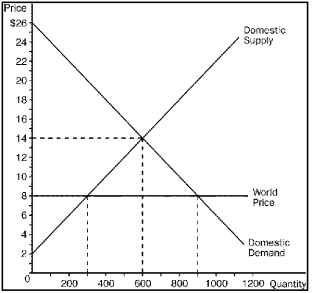 -Refer to Figure 9-13.With trade,domestic production and domestic consumption,respectively,are
-Refer to Figure 9-13.With trade,domestic production and domestic consumption,respectively,are
A) 600 and 600.
B) 600 and 300.
C) 300 and 900.
D) 600 and 900.
F) A) and C)
Correct Answer

verified
Correct Answer
verified
Multiple Choice
Tariffs and quotas are different in the sense that
A) tariffs cause deadweight losses,while quotas do not cause deadweight losses.
B) tariffs raise revenue for the government,while quotas do not raise revenue for the government.
C) tariffs enhance the well-being of domestic consumers,while quotas diminish the well-being of domestic consumers.
D) tariffs enhance the well-being of domestic producers,while quotas diminish the well-being of domestic producers.
F) A) and C)
Correct Answer

verified
Correct Answer
verified
Multiple Choice
Figure 9-1
The figure illustrates the market for wool in New Zealand. 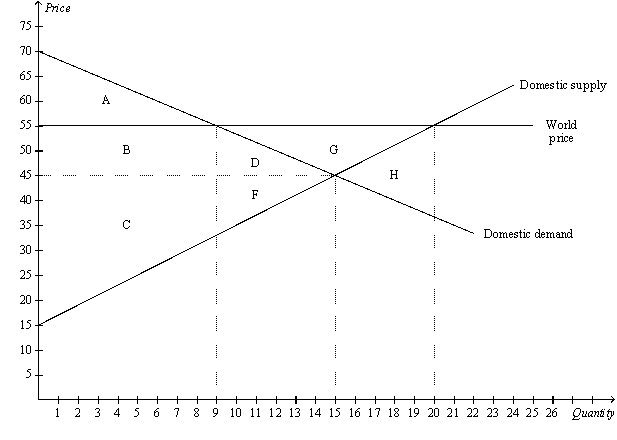 -Refer to Figure 9-1.When trade in wool is allowed,consumer surplus in New Zealand
-Refer to Figure 9-1.When trade in wool is allowed,consumer surplus in New Zealand
A) increases by the area B + D.
B) increases by the area C + F.
C) decreases by the area B + D.
D) decreases by the area D + G.
F) A) and C)
Correct Answer

verified
Correct Answer
verified
Multiple Choice
Domestic producers of a good become better off,and domestic consumers of a good become worse off,when a country begins allowing international trade in that good and
A) the country becomes an importer of the good as a result.
B) the world price exceeds the domestic price of the good that prevailed before international trade was allowed.
C) other countries have a comparative advantage,relative to the country in question,in producing the good.
D) total surplus does not change as a result.
F) B) and C)
Correct Answer

verified
Correct Answer
verified
Multiple Choice
Trade enhances the economic well-being of a nation in the sense that
A) both domestic producers and domestic consumers of a good become better off with trade,regardless of whether the nation imports or exports the good in question.
B) the gains of domestic producers of a good exceed the losses of domestic consumers of a good,regardless of whether the nation imports or exports the good in question.
C) trade results in an increase in total surplus.
D) trade puts downward pressure on the prices of all goods.
F) None of the above
Correct Answer

verified
Correct Answer
verified
Multiple Choice
Figure 9-5 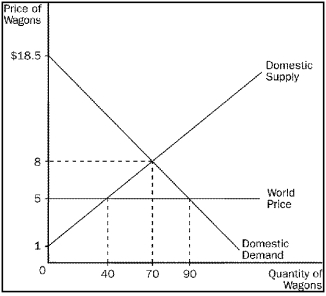 -Refer to Figure 9-5.The horizontal line at the world price of wagons represents the
-Refer to Figure 9-5.The horizontal line at the world price of wagons represents the
A) demand for wagons from the rest of the world.
B) supply of wagons from the rest of the world.
C) level of inefficiency in the domestic market caused by trade.
D) surplus in the domestic wagon market.
F) None of the above
Correct Answer

verified
Correct Answer
verified
Multiple Choice
Figure 9-15 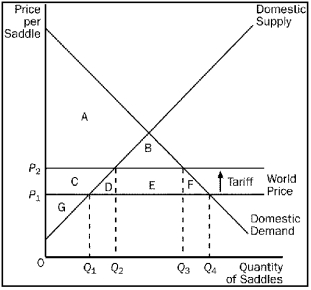 -Refer to Figure 9-15.With the tariff,the domestic price and domestic quantity demanded are
-Refer to Figure 9-15.With the tariff,the domestic price and domestic quantity demanded are
A) P1 and Q1.
B) P1 and Q4.
C) P2 and Q2.
D) P2 and Q3.
F) A) and D)
Correct Answer

verified
Correct Answer
verified
Multiple Choice
A tariff on a product makes
A) domestic sellers better off and domestic buyers worse off.
B) domestic sellers worse off and domestic buyers worse off.
C) domestic sellers better off and domestic buyers better off.
D) domestic sellers worse off and domestic buyers better off.
F) None of the above
Correct Answer

verified
Correct Answer
verified
Multiple Choice
Assume,for France,that the domestic price of tea without international trade is higher than the world price of tea.This suggests that
A) other countries have a comparative advantage over France in producing tea.
B) France has an absolute advantage over other countries in producing tea.
C) France will export tea if international trade is allowed.
D) French tea buyers will become worse off if international trade is allowed.
F) A) and D)
Correct Answer

verified
Correct Answer
verified
True/False
Most economists support the infant-industry argument because it is so easy to implement in practice.
B) False
Correct Answer

verified
Correct Answer
verified
Multiple Choice
Figure 9-17 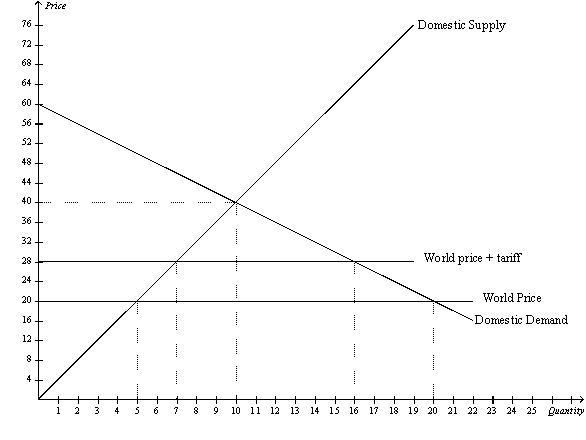 -Refer to Figure 9-17.When comparing no trade to free trade,the gain from trade is
-Refer to Figure 9-17.When comparing no trade to free trade,the gain from trade is
A) $72.
B) $100.
C) $150.
D) $450.
F) A) and C)
Correct Answer

verified
Correct Answer
verified
Multiple Choice
An important factor in the decline of the U.S.textile industry over the past 100 or so years is
A) foreign competitors that can produce quality textile goods at low cost.
B) lower prices of goods that are substitutes for clothing.
C) a decrease in Americans' demand for clothing,due to increased incomes and the fact that clothing is an inferior good.
D) the fact that the minimum wage in the U.S.has failed to keep pace with the cost of living.
F) None of the above
Correct Answer

verified
Correct Answer
verified
Multiple Choice
At present,the United States uses a system of quotas to limit the amount of sugar imported into the country.Which of the following statements is most likely true?
A) The quotas are probably the result of lobbying from U.S.consumers of sugar.The quotas increase consumer surplus for the United States,reduce producer surplus for the United States,and harm foreign sugar producers.
B) The quotas are probably the result of lobbying from U.S.producers of sugar.The quotas increase producer surplus for the United States,reduce consumer surplus for the United States,and harm foreign sugar producers.
C) The quotas are probably the result of lobbying from foreign producers of sugar.The quotas reduce producer surplus for the United States,increase consumer surplus for the United States,and benefit foreign sugar producers.
D) U.S.lawmakers did not need to be lobbied to impose the quotas because total surplus for the United States is higher with the quotas than without them.
F) C) and D)
Correct Answer

verified
Correct Answer
verified
Multiple Choice
Figure 9-2 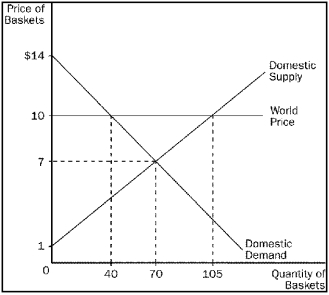 -Refer to Figure 9-2.As a result of trade,total surplus increases by
-Refer to Figure 9-2.As a result of trade,total surplus increases by
A) $80.
B) $97.50.
C) $162.50.
D) $495.50.
F) A) and C)
Correct Answer

verified
Correct Answer
verified
Multiple Choice
Figure 9-6 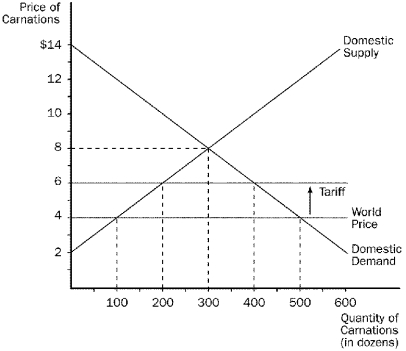 -Refer to Figure 9-6.Without trade,the equilibrium price of carnations is
-Refer to Figure 9-6.Without trade,the equilibrium price of carnations is
A) $8 and the equilibrium quantity is 300.
B) $6 and the equilibrium quantity is 200.
C) $6 and the equilibrium quantity is 400.
D) $4 and the equilibrium quantity is 500.
F) None of the above
Correct Answer

verified
Correct Answer
verified
Multiple Choice
What is the fundamental basis for trade among nations?
A) shortages or surpluses in nations that do not trade
B) misguided economic policies
C) absolute advantage
D) comparative advantage
F) A) and B)
Correct Answer

verified
Correct Answer
verified
Multiple Choice
Figure 9-2  -Refer to Figure 9-2.This country
-Refer to Figure 9-2.This country
A) has a comparative advantage in baskets.
B) should export baskets.
C) is a price taker in the world economy.
D) All of the above are correct.
F) None of the above
Correct Answer

verified
Correct Answer
verified
True/False
Tariffs cause deadweight loss because they move the price of an imported product closer to the equilibrium without trade,thus reducing the gains from trade.
B) False
Correct Answer

verified
Correct Answer
verified
True/False
NAFTA is an example of a multilateral approach to achieving free trade.
B) False
Correct Answer

verified
Correct Answer
verified
Showing 101 - 120 of 333
Related Exams